The Ares is a new wireless flash trigger from Phottix. It was announced in late September 2012 at Photokina, and is available for purchase from 25 October 2012.
The Ares is designed as a no-frills flash trigger that is easy to use, and provides reliable triggering, at an affordable price.
The Phottix Ares is due for release in October 2012, and will replace several of the older Phottix flash triggers, including the Tetra, Aster, and the original Strato.
Features
The Phottix Ares Flash Trigger has the following features:
- Triggers hot shoe flashes and studio lights
- Rotating transmitter can be used in up or down position
- Reliable digitally-encoded signals
- Cold shoe and 1/4" threaded insert on receiver
- Includes PC sync cable and batteries
| Frequency | 2.4 GHz |
| Range | 200 metres + |
| Channels | 8 channels and Fire-All function |
| Batteries |
2 x AA in transmitter and in receiver
5V DC socket for external power supply on receivers |
| Max sync speed | 1/250 seconds (1) |
| Antenna | built-in internal PCB antenna |
| Transmitting Power | > 6dBm |
| Receiver Ports: | 3.5mm sync port, hot shoe output |
| Operating Temperature | 0°C to 40°C |
| Working Humidity | 35% to 95% RH |
| 1. | on compatible cameras and flashes |
One of the key features of the Ares is the rotating transmitter mount. It allows photographers to use the transmitter in an upright position, for easy access to the controls, or folded down to make it more compact.
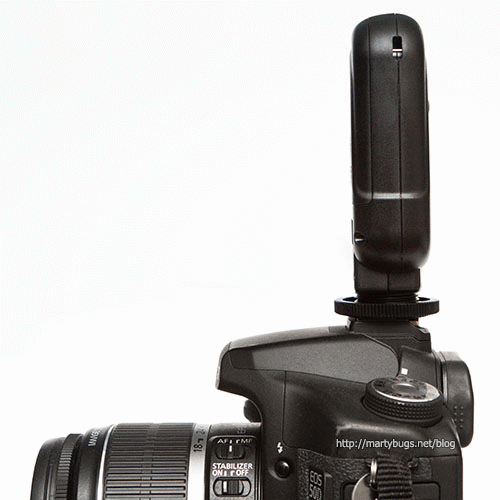
The transmitter can easily be rotated from the upright position to the folded-down position, and has a very satisfying click as it locks into each position.
Let's take a closer look at the Ares transmitter and receiver.
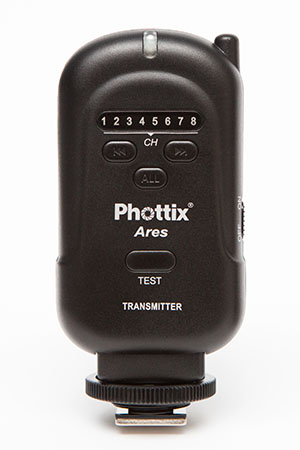
Phottix Ares transmitter
|
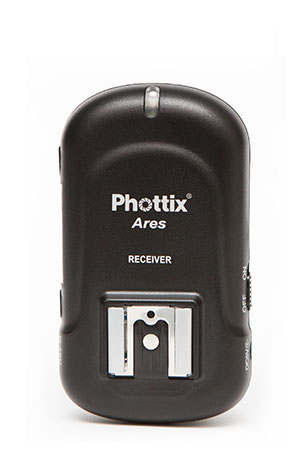
Phottix Ares receiver
|
The Ares transmitter has a metal hotshoe mount, with a locking ring to ensure it won't move once you have attached it to your camera. The buttons and switches on the transmitter include:
- on/off switch - for turning the device on and off
- test button - for manually triggering any receivers configured to use the same channel
- channel up/down selector buttons - for changing the selected channel
- fire-all button - for toggling between a single channel and all channels
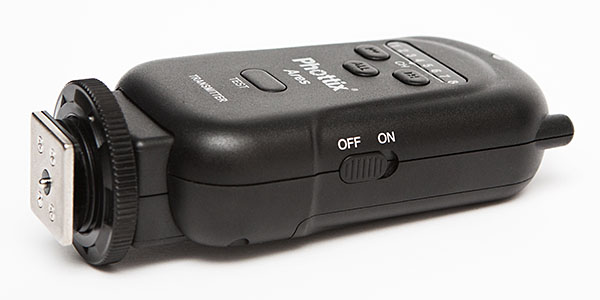
The channel indicator on the transmitter shows the currently selected channel by lighting up a red LED behind the appropriate channel number. Hitting the "ALL" button toggles the transmitter from a single channel to all channels, and causes LEDs to light up behind all eight channel numbers.
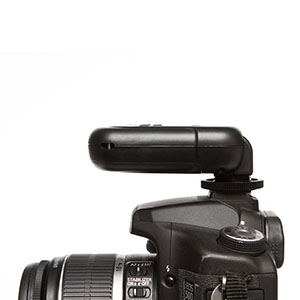
transmitter folded down
|
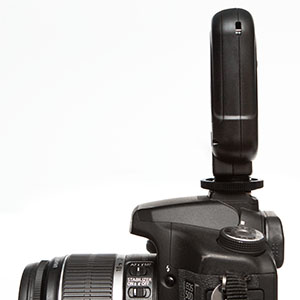
transmitter upright
|
The rotating mount on the transmitter is an interesting feature - and something that I found very useful.
I am not sure how the transmission range is affected (if at all) with the transmitter folded down.
The bottom of the Ares receiver features a plastic cold shoe mount with a locking ring, as well as a 1/4" threaded metal socket. This provides flexibility for mounting the receiver, allowing you to use either the plastic cold shoe mount, or the socket for mounting it on a flash stand or other bracket.
I generally avoid using the plastic cold shoe mount, and prefer to use the 1/4" threaded socket for a more rigid and solid mounting solution, as the plastic shoe flexes a little when a heavy flash unit is mounted on top of the receiver.
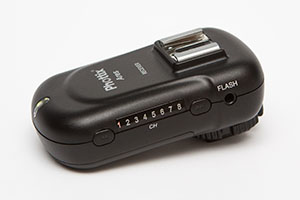
Phottix Ares transmitter
|
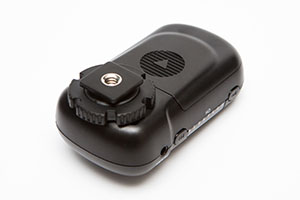
Phottix Ares transmitter
|
The channel indicator and channel selection buttons on the receiver are identical to those found on the transmitter, allowing you to select an individual channel for each receiver.
A 3.5mm socket on the side of the Ares receiver provides connectivity to flashes and studio lights via a PC sync cable.
The Phottix Ares is very easy to use. Mount the transmitter onto the hotshoe of your camera, and turn it on. Connect a flash to the hotshoe on the receiver, and turn on the receiver and the flash. Then select the channel to use on both the transmitter and the receiver, adjust the power settings on the flash, and you are ready for some strobist action.
When the transmitter and receiver are powered on, they remember the last-used channel settings. This means you don't always have to think about setting the channel each time you use the Ares, and also ensures all Ares users won't always be defaulting to the same channel!
If you are using multiple Ares receivers, you can set them to different channels, and configure the transmitter to trigger just a single channel, or trigger all channels at once.
Being able to select a single channel, or all eight channels isn't quite as flexible as the Phottix Strato II, where you can toggle each of the four channels on or off.
When powered on, the status LED on both the transmitter and the receiver slowly flashes green. The transmitter's status LED flashes red when it is triggered, and similarly the receiver's status LED also flashes red when triggered.
The TEST button on the transmitter provides functionality for testing communications between the transmitter and receiver, and will cause the receiver to trigger any attached flash.
Phottix indicate the Ares supports a maximum flash sync speed of 1/250 seconds, depending on camera and flash capabilities. Some testing with a Canon 50D camera and a Canon 580EX II flash, with the flash at 1/128 power, confirm this.

full sync at 1/250 sec
|

almost full sync at 1/320 sec
| |

partial sync at 1/400 sec
|

partial sync at 1/500 sec
| |
As shown in the photos above, full sync is achieved at 1/250 seconds, and interestingly, full sync is almost achieved at 1/320 seconds, with just a hint of a shadow at the bottom of the frame. As expected, increasing the shutter speed any higher clearly shows partial synchronisation.
The build quality of the Ares is up to Phottix's usual high standards, with both the transmitter and receiver being constructed of a strong plastic. They feel very robust in the hand, and I am confident they can handle being bounced around in your camera bag.
The battery cover fits very well, and locks nicely into place, so you know you won't end up with batteries rolling around in the bottom of your camera bag.
The power buttons on the Ares transmitter and receiver are a little different from those used on other Phottix remotes. The slightly lower profile of the switches will help prevent the remotes from being accidentally powered on or off, while still being easy to move with a finger tip.
I was initially wary of the quality of the rotating transmitter mount, but found that it continues to move easily, with a solid and satisfying click as it locks into each position.
Surprisingly, the Phottix Ares is not compatible with any other existing Phottix triggers.
As a low-cost no-frills trigger, Phottix are likely to be targeting photographers who do not yet have a flash trigger, and lack of compatibility will not be an issue for those buyers.
However, when those photographers decide to expand their wireless triggering options in the future, and buy a Phottix Odin or similar, they will not be able to trigger their Ares receivers with the Odin.
The Odin transmitter can trigger Strato and Strato II receivers (with the flash power set manually as the Strato and Strato II do not support TTL).
As the Ares is replacing several of the older Phottix flash triggers, including the Strato, I expected the Ares receiver to be able to be triggered by other Phottix transmitters (such as the Odin), but that is not the case.
Phottix's use of 2.4GHz provides reliable triggering, and the range of 200m+ that should be more than sufficient for most photographers.
The "fire-all" mode provides flexibility, allowing you to set receivers on different channels, and trigger one of the eight channels at a time while setting up lights. Switching to the "fire-all" mode then allows you to trigger all receivers at once.
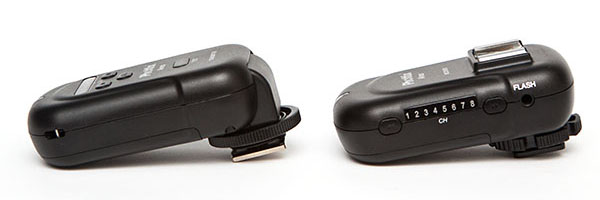
The use of AA batteries in both the receiver and transmitter (two AA batteries in each) is very convenient. Many earlier flash triggers used a variety of batteries, ranging from AAA to CR2 and more exotic types. This meant carrying spare batteries of multiple types - to ensure you would not be in a situation with flat batteries in one of your devices.
By using the same batteries as your flash, spare AA batteries for your flash can also be used in the Areas.
While the AA batteries in the Ares transmitter and receiver means they are somewhat larger than other flash triggers that use smaller batteries, the convenience of using the same batteries as your flashes more than outweighs this disadvantage.
The Phottix Ares is designed to be a cheaper no-frills flash trigger that is easy to use, and provides reliable triggering.
I think Phottix have achieved their aim with the Ares, and it provides great value for money. The lack of compatibility with other Phottix triggers is a bit of a disappointment, but is only an issue for those who already own other triggers, or Ares users who may want to upgrade in the future.
The Phottix Ares wireless flash trigger is now available from the Phottix online store for USD$62.50 (includes one transmitter and one receiver).
Note that the Phottix Ares flash trigger is a no-frills flash trigger, with no support for Canon's ETTL or Nikon's iTTL functionality. This trigger simply provides a means to remotely trigger one or more flashes, but you need to set the flash output manually on each flash (and the flashes need to be switched to manual mode).
For something with a bit more functionality, the Phottix Strato II has remote flash wake-up functionality, and the transmitter has a hot-shoe with pass-through TTL, allowing you to mount a flash on top of the transmitter.
For third-party wireless flash triggers with full ETTL / iTTL support, you need to look at much more expensive solutions, such as some of the newer PocketWizards, Radio Poppers, Pixel King, the Phottix Odin (my favourite), or the recently announced Phottix Strato TTL trigger.
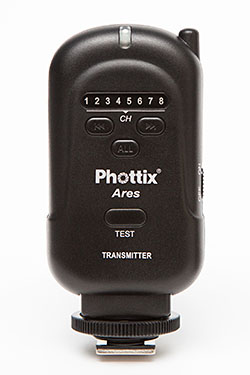
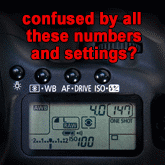


Thank you for a great walk-through about this product. I'm highly considering it as a simple solution to trigger my speedlight. I do have one question. The select all channels from the transmitter is a great features but if there's another photographer using the same trigger in the same room with me. His trigger can trigger my receiver if he select all channels from his tranmitter is it?
Thank you,
Dee